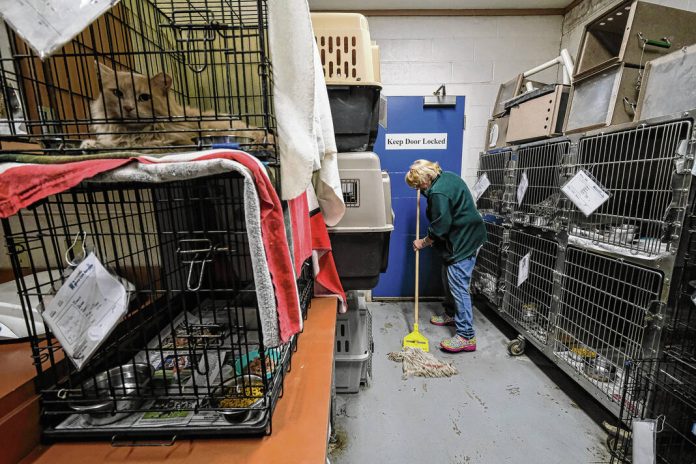
Mike Wolanin | The Republic Diane Burchett mops around pet carriers and cages full of cats in the special care area at Columbus Animal Care Services in Columbus, Ind., Thursday, Dec. 28, 2023. The shelter is inundated with cats. The garage and special care areas have been turned into overflow areas lined with pet carriers and cages to house the cats at the shelter.
Local animal shelters have moved into uncharted territory as overcrowded conditions are complicating their operations.
Bartholomew County Humane Society shelter director Kirsten VantWoud said her staff and volunteers established a new fall record from Dec. 1 – 17 by finding homes for 54 dogs and cats during a Empty the Shelters adoption campaign.
But the gains were quickly wiped away. In December, the Humane Society took in 72 animals, VantWoud said. As of Dec. 28, the shelter at 4415 E. County Road 200S had 83 cats, the shelter director said. That’s well above the 50-cat capacity of the shelter. In addition, 18 cats were in foster homes, she said.
“This is unprecedented,” said VanWoud, who has more than 30 years experience as a registered veterinary technician or animal shelter administrator. “I’ve never seen anything like it.
Columbus Animal Care Services had 60 cats at its shelter and 47 in foster homes, general manager Nicohl Birdwell Goodin said.
“I don’t know when we have been this full,” said Birdwell Goodin, who has led the shelter since June 2013. “We have cats stacked in crates within our garage. That’s never happened before.”
VantWoud and Birdwell Goodin say serious overcrowding became evident in October. Usually, the feline population grows at a slower rate from October to March, VantWoud said.
But there are likely multiple factors that increased that population during the final three months of the year, according to the shelter managers.
For example:
- Female cats may have gone into heat for additional cycles as a result of milder and drier conditions.
- Inflation may have forced low-income pet owners to choose between paying essential bills and caring for their pets.
- Those who obtained pets during the Covid-19 pandemic may have found caring for the dog or cat too troublesome after returning to work.
Under normal circumstances, the most effective way of handling overcrowding would be having pets undergo a surgical procedure to prevent reproduction. But many of the spay-neuter clinics have either shut down or drastically cut back largely due to a shortage of veterinarians, Birdwell Goodin said.
There are clinics that focus only on spay-neuter, as well as providing necessary vaccines, that were established to handle large numbers of animals. Some clinics are reporting their intake had doubled, or in some cases, tripled in 2023.
“With higher prices, people struggling to maintain their pet have lowered getting their pet fixed further down their priority list,” Birdwell Goodin said.
Efforts to continue a trap-neuter-release program have been made by Columbus Animal Care, but Birdwell Goodin says her staff has their hands full caring for the animals in the overcrowded shelter and trying to move them out into the community.
Shelter officials have also noted two cases of after-hours abandonment of animals, two in November and two in December, VantWoud said.
The most recent case involves a cat that was left outside the shelter after-hours on Dec. 20. The microchipped cat was traced to a Rushville animal shelter, which had records the feline was adopted to a family 26 miles away from Columbus in Trafalgar.
Similar cases of abandonment have also taken place at Columbus Animal Services this year. Birdwell Goodin said.
“You’re walking into work and there’s a dog tied to a bike rack, or a box moving across the sidewalk,” the city shelter manager said. “We also find empty boxes. You know something was in it, but you don’t know what it was.”
VantWoud says some individuals tell lies to persuade the shelter into taking their dogs or cats. In one case, a family brought in an abandoned litter, claiming to have just found them on the roadside. But a few days later, she discovered the family was bragging about how the family pet had just given birth to a litter on a social media post, VantWoud said.
But there has already been some relief. The Humane Society has been able to maintain positive relationships with similar organizations such as the Community Animal Rescue Effort (C.A.R.E., Inc.) and the Brown County Humane Society. VantWoud says both of those organizations have been very helpful to her shelter recently.
In addition, an encouraging number of families and individuals have recently stepped forward to volunteer as a foster family, the shelter directors said. And while there is a slight overcrowding of dogs at the two shelters, neither VantWoud nor Birdwell Goodin say canines are a problem at this time.
How you can help
- Have your pet spayed or neutered. While immediate available appointments are difficult to find, the Humane Society shelter will provide you with a list of low-cost spay/neuter clinics.
- If finances are an issue, ask local shelters for assistance in caring for pets.
- Consider fostering a pet. Food, cat litter and vaccinations are paid for by shelter. Short-term fostering is available.
- Don’t give pets as gifts. Instead, bring the intended primary caregiver to a shelter to make their own decisions and commitments. Remember that you are asking them for what could be a 15-year commitment.
- Avoid adopting a cat or dog if you expect to be away from home overnight within a month.
- Volunteer at an animal shelter. Check social media outlets maintained by local animal shelters to see what is needed.
- Use your own social media page to let others know about pets available for adoption.
Sources: Columbus Animal Care Services General Manager Nicohl Birdwell Goodin and Bartholomew County Humane Society shelter director Kirsten VantWoud




